
A Visit to Wittenberg
Happy Reformation Day! Today, 499 years ago, Martin Luther nailed his 95 theses to the door of the Castle Church in Wittenberg. This action touched off a spiral of events that led to the Protestant Reformation – a movement that placed a renewed emphasis on the Bible and God’s grace to the world through Jesus Christ. To celebrate, I thought I would ‘show you around’ the city with several photos.
I was blessed with the opportunity to visit Wittenberg in June, 2015. While I was not able to actually visit the interior of the Castle Church itself (it is closed for renovation, in preparation for next year’s 500 year anniversary), I was able to visit a number of other sites in this historic town. Enjoy the tour!
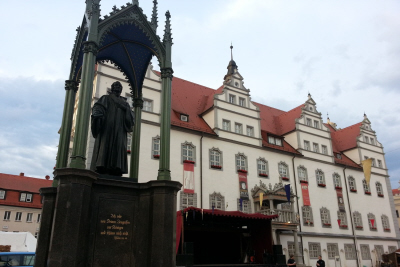
This is Wittenberg, officially ‘Lutherstadt Wittenberg.’ While a small town, then and now, it would gain fame as the starting point of the Reformation and the home of the reformer Martin Luther.
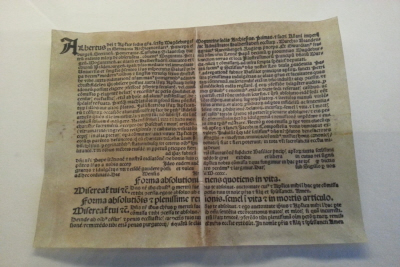
By the time of Luther, ‘Indulgences,’ like this one, were sold by the Roman Catholic Church to finance building projects. These documents were given by the approval of the Pope, and with them he conferred ‘forgiveness’ of sins. While the use of indulgences is one of the more obvious abuses of the papacy, the Reformation did far more than correct this – it reemphasized the reality that it is the grace of Christ, not the works of man or the indulgences of Popes, that confer forgiveness.
“Whenever secular authorities are presumptuous enough to make spiritual laws for the soul, they interfere with God’s regiment and only tempt as well as ruin the souls. In short, this is the meaning as St. Peter says, ‘We must obey God rather than men.’ Thereby, he clearly sets a limit to the secular authority. Do not resist authorities with violence, but only with confessing the truth.”
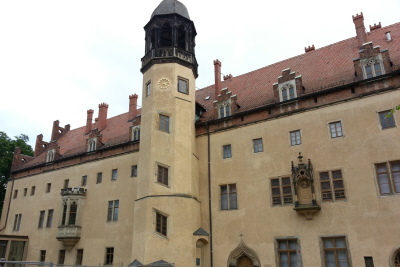
Breaking with Roman Catholic tradition, Martin Luther recognized the Biblical value of marriage and family. He lived in the Luther House with his wife, Katharina von Bora. It was from this site that he ministered and raised a family.

One significant work of Martin Luther was the translation of the Bible into German, pictured here is the first complete translation.
Luther summarized his basic approach to the interpretation of the Bible: “The gospel is so clear that it does not need a great deal of interpretation, but it wants to be carefully looked at and deeply taken to heart.”

The most famous room inside the Luther House is the living room, where Luther convened with his friends after dinner. Many informative discussions on Christian life occurred in this room, and were recorded by his students in a book titled ‘Table Talks.’

At another place in the house is a small tower, where Luther poured over the Bible. He said of this place, “In this tower the Holy Spirit revealed Scripture to me.”
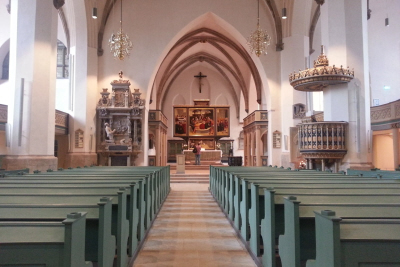
The City Church, or Stadtkirche, is considered the ‘mother church of the reformation.’ Luther and other reformers preached from this church.
The time of silence is gone and the time of preaching is come.

Another famous building, the Melanchthon House, was the residence of an important assistant to Luther, Philip Melanchthon.
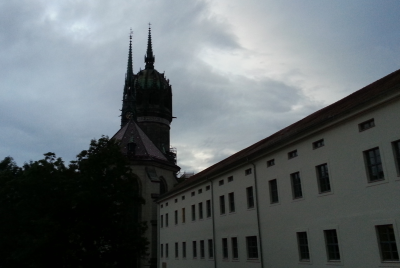
Finally, the most famous building in Wittenberg is the Castle Church, or Schlosskirche. It was on the door to this building that Luther nailed his 95 Theses. It was, of course, a great disappointment to me that I was not able to visit the inside due to construction. However, today the church is connected to a youth hostel, which is housed inside the white building. So, incredibly, I was able to spend a night in the back of the Castle Church.
Thanks for joining me on this tour. As a final highlight, consider the words of Martin Luther – as fitting for today as they were nearly 500 years ago:
Where Christ is, there He always goes against the flow.




Sorry Daniel. I’m in disagreement here. The Refromation brought us the confusing mess we have today. God is not the author of confusion. There once was two churches. True churches and evil false churches. Today there are true churches and thousands of evil false churches some not so evil as others but still false. It’s much harder to find a true persecuted church today. Therefore many more people are finding the many false churches and don’t here the true gospel. Is this what Jesus had in mind when He said”I will build my church”? The reformers should have left the Roman church and united with the true churches instead of starting their own church. There is Jesus’ Church, Luther’s church, Calvin’s church, etc. I support Jesus’s Church. To “me” this is a great issue for today.
I appreciate you work. Please consider my comments.
Thanks for the tour, Daniel. Awesome photos!
Happy Reformation Day indeed! Great pictures. Love hearing about the history. Being a MO Synod Lutheran, I am in awe of what Martin Luther did. It is not easy going against the flow. He did so by the grace of God. Thanks be to God!
Praise our God and King, He has not left us without an easily readable Word in thousands of languages, and He has raised up men and women that fought the good fight and continues to do so. I am thankful to see His work and the love the saints have for Him.